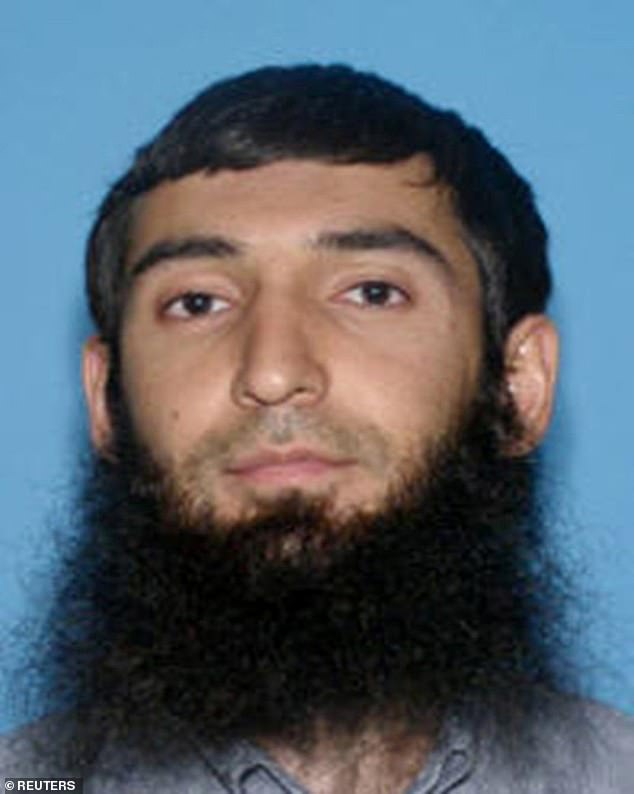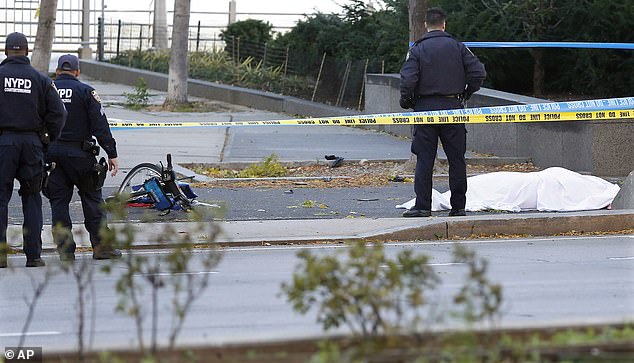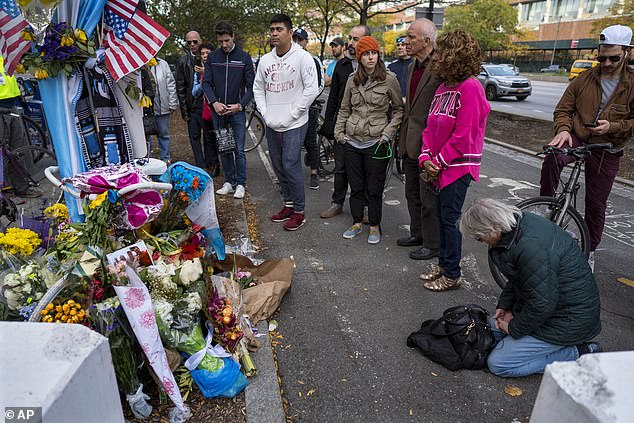Prosecutors will ask a New York jury for the death penalty for the man behind a 2017 truck rampage
>
A man who killed eight people while intentionally driving a Home Depot rental van along a Manhattan bike lane in 2017 could become the first person in six decades to be executed in New York state.
This week, prosecutors will ask a jury in the Southern District of New York to sentence Sayfullo Saipov, 35, to death for the attack after he was convicted of federal crimes in January.
Saipov drove the truck across the George Washington Bridge from New Jersey on Halloween 2017 before turning onto a bike path on the west side and striking nearly a dozen pedestrians and cyclists.
After crashing into a school bus, he jumped out of the truck and threatened people with fake weapons.
New York state has not had the death penalty since 2004, but it can still be applied for the federal crimes Saipov was convicted of. If the jury decides not to sentence him to death, he will receive life in prison without parole.
The execution of Sayfullo Saipov, 35, a citizen of Uzbekistan, would be an extreme rarity in New York. The state no longer has capital punishment and the last state execution was in 1963

Saipov intentionally drove a Home Depot rental van down a Manhattan bike lane in 2017. Prosecutors will ask a jury this week to sentence him to death.
On Thursday, Saipov’s lawyers tried to overturn the government’s decision to seek the death penalty because the Biden administration placed a moratorium on federal executions.
Specifically, they cited the government’s decision not to seek the death penalty for Patrick Crusius, who was found guilty of a 2019 shooting in El Paso, Texas, that killed 23 people. Therefore, the defense argued that Saipov was being discriminated against because of his ethnic origin.
“Given the recent decision to accept Patrick Crusius’s guilty plea to life in prison despite his unrepentant and premeditated hateful murder of 23 Latinos at a Walmart in El Paso, Texas – Crusius is a white citizen born in the United States – the Court should be deeply concerned that a driving force behind the death notice in this case is Mr. Saipov’s religion and national origin, in violation of the Fifth and Eighth Amendments,” said defense attorney David Patton.
‘[After the attack] Then-President Trump persistently demanded that Mr. Saipov face the death penalty based on nothing more than an inordinate assessment of his crime and his identity as an Uzbek Muslim immigrant who won the diversity visa lottery, an aspect of Uzbek policy. immigration from the United States that was long the focus of the Trump Administration’s ire,” the defense added.
His lawyers had previously said the death penalty process was flawed by Trump, who he tweeted a day after the attack that Saipov ‘SHOULD GET THE DEATH PENALTY!’
Saipov bowed his head last month when he heard the verdict in a Manhattan courthouse, just blocks from where the attack ended.
Prosecutors said the rampage was inspired by his reverence for ISIS.
The dozen jurors deliberated for about seven hours over two days before convicting him of 28 counts of crimes including murder in aid of organized crime and support of a foreign terrorist organization.

Sayfullo Habibullaevic Saipov, 35, repeatedly proclaimed his support for ISIS following the 2017 attack, during which he allegedly plowed through a crowd on a New York bike path.
Jurors must now hear more evidence to help them decide whether he should be executed or spend the rest of his life in prison. A federal jury in New York has not handed down a death sentence that has withstood legal appeals since 1954.
His attorneys admitted to the jury that he rented a van near his New Jersey home, drove it down the road along the Hudson River and plowed past cyclists for blocks before crashing into a school bus near the World Trade Center.
He got out of his truck shouting ‘God is great’, in Arabic, with pellet guns and paintballs in his hands before a police officer shot him because he thought they were real firearms.
Vehicle attack killed a woman visiting from Belgium with her family, five friends from Argentina and two Americans. She left others with permanent injuries, including a woman who lost her legs.

Sayfullo Saipov bowed his head as he heard the verdict in a Manhattan courthouse a few blocks from where the attack ended.

A New York City police officer stands next to a body covered in a white sheet near a vandalized bicycle along a bike path.
“His actions were reckless, horrific, and there is no justification for them,” Patton told the jury during his trial.
The defense asked the jury to acquit Saipov of the extortion charges, saying he intended to die a martyrdom and was not colluding with the Islamic State organization, despite voluminous amounts of the group’s propaganda found on his electronic devices. and in his house.
Saipov did not testify at his trial. Instead, he sat silent every day, unlike at a 2019 pre-trial hearing where he insisted on asking the judge why he should stand trial for eight deaths when “thousands and thousands of Muslims are dying around the world.” .
Saipov legally moved to the US from Uzbekistan in 2010 and lived in Ohio and Florida before joining his family in Paterson, New Jersey.

A paramedic looks at a body covered by a white sheet along a bike path after the riot

Five members of this group of Argentine friends were also killed. They are Hernán Diego Mendoza (far left), Alejandro Damián Pagnucco (second from left), Ariel Erlij (third from left), Diego Enrique Angelini (second from right) and Hernán Ferruchi (third from right).


New Jersey resident Darren Drake, 32, and Belgian tourist Ann-Laure Decadt, 31, were killed

Nicholas Cleves, 23, was the only New Yorker to be killed. His mother was unable to attend the funeral because the mayor’s office only informed her of the service at 4 pm Tuesday.

A group pauses, with some in prayer, at a makeshift memorial on a New York City bike path.
Prosecutors said Saipov attacked civilians to impress the Islamic State group so he could become a member and he seemed pleased with his work, smiling when he spoke to an FBI agent afterwards.
Among those who testify Several family members from Belgium were injured in the attack. Aristide Melissas, a father, said he had challenged family members to bike rides to the World Trade Center, with the loser paying for the ice cream. When he was hit by Saipov’s truck, he fractured his skull. He underwent brain surgery.
His wife, Marion Van Reeth, spoke of waking up in a hospital to find that her legs had been amputated.
Until Saipov’s trial, Biden’s Justice Department, under the direction of Attorney General Merrick Garland, had not launched any new attempts to obtain the death penalty in a federal case. But Garland has allowed US prosecutors to continue advocating capital punishment in cases handed down from previous administrations.
It’s been a decade since a jury in New York last considered the death penalty.
Federal juries in Brooklyn twice sentenced a man who murdered two NYPD detectives to death, once in 2007 and again in 2013, but both sentences were overturned on appeal. A judge eventually ruled that the killer had an intellectual disability.
In 2001, just weeks before the 9/11 attacks, federal juries in Manhattan refused to impose the death penalty on two men convicted of the deadly bombings of two US embassies in Africa. Lawyers for the men had urged jurors not to make martyrs of the defendants.
